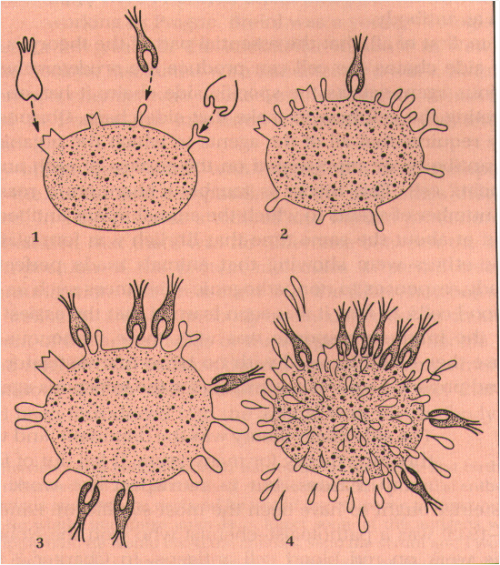We-are-all-paranoid - Microbe Nerd Alert

More Posts from We-are-all-paranoid and Others

a photo of a rhondrophyta tetrasporophyte under a microscope from my botany class <3
Slime Molds and Intelligence

Okay, despite going into a biology related field, I only just learned about slime molds, and hang on, because it gets WILD.
This guy in the picture is called Physarum polycephalum, one of the more commonly studied types of slime mold. It was originally thought to be a fungus, though we now know it to actually be a type of protist (a sort of catch-all group for any eukaryotic organism that isn't a plant, animal, or a fungus). As protists go, it's pretty smart. It is very good at finding the most efficient way to get to a food source, or multiple food sources. In fact, placing a slime mold on a map with food sources at all of the major cities can give a pretty good idea of an efficient transportation system. Here is a slime mold growing over a map of Tokyo compared to the actual Tokyo railway system:

Pretty good, right? Though they don't have eyes, ears, or noses, the slime molds are able to sense objects at a distance kind of like a spider using tiny differences in tension and vibrations to sense a fly caught in its web. Instead of a spiderweb, though, this organism relies on proteins called TRP channels. The slime mold can then make decisions about where it wants to grow. In one experiment, a slime mold was put in a petri dish with one glass disk on one side and 3 glass disks on the other side. Even though the disks weren't a food source, the slime mold chose to grow towards and investigate the side with 3 disks over 70% of the time.

Even more impressive is that these organisms have some sense of time. If you blow cold air on them every hour on the hour, they'll start to shrink away in anticipation when before the air hits after only 3 hours.
Now, I hear you say, this is cool and all, but like, I can do all those things too. The slime mold isn't special...
To which I would like to point out that you have a significant advantage over the slime mold, seeing as you have a brain.
Yeah, these protists can accomplish all of the things I just talked about, and they just... don't have any sort of neural architecture whatsoever? They don't even have brain cells, let alone the structures that should allow them to process sensory information and make decisions because of it. Nothing that should give them a sense of time. Scientists literally have no idea how this thing is able to "think'. But however it does, it is sure to be a form of cognition that is completely and utterly different from anything that we're familiar with.
biologists will be like this is a very simplified diagram of a mammalian cell

chemists will be like this is a molecule


is there a name for this






The Good Place (2016-2020)






Journey to the Microcosmos- Flatworms: Simple Wiggly Tubes
Images Originally Captured by Jam’s Germs
Quote Voiced by Jam’s Germs



‘aBiogenesis’ Reimagines the Primordial Soup Theory in a Mesmerizing Animation by Markos Kay

The public paid for "Moderna's" vaccine, and now we're going to pay again (and again and again)

Moderna is quadrupling the cost of covid vaccines, from $26/dose to $110–130. Moderna CEO Stephane Bancel calls the price hike “consistent with the value” of the mRNA vaccines. Moderna’s manufacturing costs are $2.85/dose, for a 4,460% markup on every dose:
https://arstechnica.com/science/2023/01/moderna-may-match-pfizers-400-price-hike-on-covid-vaccines-report-says/
If you’d like an essay-formatted version of this thread to read or share, here’s a link to it on pluralistic.net, my surveillance-free, ad-free, tracker-free blog:
https://pluralistic.net/2023/01/24/nationalize-moderna/#herd-immunity
Keep reading

Antibodies are the secreted form of B-lymphocyte receptors and are a part of adaptive immunity, but how are these proteins formed?
Above is a diagram illustrating Paul Ehlrich’s Side Chain Theory of Antibody Formation. Ehlrich proposed that immunoglobulin molecules, a fundamental component of adaptive immunity, served as membrane bound proteins that bound to particular threats, similarly to the former “key in lock” view of enzymes in catalyzing biological reactions. Ehrlich also suggested that the action of binding a pathogenic molecule to the receptor would generate a signal to stimulate the production of more receptors of the same specificity. These “side chains” that were added on would then break off from the cell surface and become what we call antibodies.
We now know, however, that soluble immunoglobulin receptors are specially manufactured to be secreted as antibody, rather than just “breaking off” of the lymphocyte, even though they have the same specificity as their membrane-bound counterparts.
-
 catalllo reblogged this · 1 week ago
catalllo reblogged this · 1 week ago -
 devourerofmugsofcoffe liked this · 2 weeks ago
devourerofmugsofcoffe liked this · 2 weeks ago -
 seventyeight-moose reblogged this · 1 month ago
seventyeight-moose reblogged this · 1 month ago -
 thevoidparent reblogged this · 1 month ago
thevoidparent reblogged this · 1 month ago -
 toesucker416 reblogged this · 1 month ago
toesucker416 reblogged this · 1 month ago -
 kapitanet-blog liked this · 1 month ago
kapitanet-blog liked this · 1 month ago -
 eukrasian reblogged this · 1 month ago
eukrasian reblogged this · 1 month ago -
 phrooggie liked this · 1 month ago
phrooggie liked this · 1 month ago -
 talcs reblogged this · 1 month ago
talcs reblogged this · 1 month ago -
 talcs liked this · 1 month ago
talcs liked this · 1 month ago -
 down-with-capitalism liked this · 1 month ago
down-with-capitalism liked this · 1 month ago -
 princess-queso liked this · 1 month ago
princess-queso liked this · 1 month ago -
 kickasstorrents liked this · 1 month ago
kickasstorrents liked this · 1 month ago -
 nmri reblogged this · 1 month ago
nmri reblogged this · 1 month ago -
 misha-amane liked this · 2 months ago
misha-amane liked this · 2 months ago -
 pamyuite reblogged this · 2 months ago
pamyuite reblogged this · 2 months ago -
 tgirl-autumn reblogged this · 2 months ago
tgirl-autumn reblogged this · 2 months ago -
 nanami reblogged this · 2 months ago
nanami reblogged this · 2 months ago -
 nanami liked this · 2 months ago
nanami liked this · 2 months ago -
 paperbagirlratlover liked this · 2 months ago
paperbagirlratlover liked this · 2 months ago -
 sploon-fic-fan reblogged this · 2 months ago
sploon-fic-fan reblogged this · 2 months ago -
 solangelos-cats liked this · 2 months ago
solangelos-cats liked this · 2 months ago -
 theswaggot reblogged this · 2 months ago
theswaggot reblogged this · 2 months ago -
 misunderstandings-georg reblogged this · 2 months ago
misunderstandings-georg reblogged this · 2 months ago -
 funguin liked this · 2 months ago
funguin liked this · 2 months ago -
 thenewborndeity reblogged this · 2 months ago
thenewborndeity reblogged this · 2 months ago -
 caffeinatedcutie3 reblogged this · 2 months ago
caffeinatedcutie3 reblogged this · 2 months ago -
 caffeinatedcutie3 liked this · 2 months ago
caffeinatedcutie3 liked this · 2 months ago -
 pamyuite liked this · 2 months ago
pamyuite liked this · 2 months ago -
 accursedacolyte reblogged this · 2 months ago
accursedacolyte reblogged this · 2 months ago -
 jinxthechaotic liked this · 2 months ago
jinxthechaotic liked this · 2 months ago -
 r0semultiverse reblogged this · 2 months ago
r0semultiverse reblogged this · 2 months ago -
 lunararo liked this · 2 months ago
lunararo liked this · 2 months ago -
 dragonsfuryl liked this · 2 months ago
dragonsfuryl liked this · 2 months ago -
 im-in-your-mind liked this · 2 months ago
im-in-your-mind liked this · 2 months ago -
 ilovejosukehigashikata reblogged this · 2 months ago
ilovejosukehigashikata reblogged this · 2 months ago -
 aciidfairy liked this · 2 months ago
aciidfairy liked this · 2 months ago -
 delthea reblogged this · 2 months ago
delthea reblogged this · 2 months ago -
 madeliefde reblogged this · 2 months ago
madeliefde reblogged this · 2 months ago -
 funfettified liked this · 2 months ago
funfettified liked this · 2 months ago -
 channist liked this · 2 months ago
channist liked this · 2 months ago -
 patchoulioils liked this · 2 months ago
patchoulioils liked this · 2 months ago -
 stoneoceaan liked this · 2 months ago
stoneoceaan liked this · 2 months ago -
 20skulls liked this · 2 months ago
20skulls liked this · 2 months ago
